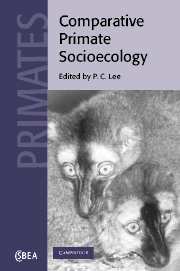Book contents
- Frontmatter
- Contents
- List of contributors
- Preface
- Part 1 Comparative methods
- 1 The comparative method: principles and illustrations from primate socioecology
- 2 Cladistics as a tool in comparative analysis
- 3 Phylogenetically independent comparisons and primate phylogeny
- Part 2 Comparative life history and biology
- Part 3 Comparative socioecology and social evolution
- Editor's conclusion: Socioecology and social evolution
- Index
3 - Phylogenetically independent comparisons and primate phylogeny
Published online by Cambridge University Press: 24 August 2009
- Frontmatter
- Contents
- List of contributors
- Preface
- Part 1 Comparative methods
- 1 The comparative method: principles and illustrations from primate socioecology
- 2 Cladistics as a tool in comparative analysis
- 3 Phylogenetically independent comparisons and primate phylogeny
- Part 2 Comparative life history and biology
- Part 3 Comparative socioecology and social evolution
- Editor's conclusion: Socioecology and social evolution
- Index
Summary
Introduction
Comparisons among species provide a wealth of information about evolution that could not otherwise be obtained. Experiments cannot generally be conducted over evolutionary time, but interspecies variation can be viewed as the results of natural experiments (Harvey and Pagel, 1991; Harvey and Purvis, 1991). Unfortunately, nature tends to use lousy experimental designs (Harvey and Pagel, 1991; Rees, 1995; Nee, Read and Harvey, 1996), complicating the analysis of multispecies data. The difficult-ies stem from the obvious fact that closely related species tend to be similar, whereas standard statistical tests of association assume independence of data points (Felsenstein, 1985). This chapter explores the analogy between comparative and experimental data, to highlight the pseudoreplication inherent in analyses that treat species or higher taxa as independent points. To be statistically valid, comparative tests of evolutionary hypotheses have to consider the relationships among the species, i.e. their phylogeny. How much difference phylogenetic methods can make is illustrated, using an example concerning the evolution of primate bacula. An outline is given of the logic of the most popular current phylogenetic comparative approach – independent comparisons or independent contrasts (IC) (Felsenstein, 1985) – and one implementation of the IC approach, Comparative Analysis by Independent Contrasts (CAIC), is described (Purvis and Rambaut, 1995).
Because estimates of phylogeny underpin comparative tests, we consider how they can be constructed and what features they should ideally possess. An estimate (Purvis, 1995a) of the relationships among all extant primate species is discussed.
The chapter also addresses some recent misconceptions about IC analyses, and emphasises that comparisons that do not consider phylogeny are likely to mislead and cannot be justified.
- Type
- Chapter
- Information
- Comparative Primate Socioecology , pp. 44 - 70Publisher: Cambridge University PressPrint publication year: 1999
- 63
- Cited by



